Article Outline
Figures and tables
Volume 7 Issue 1 > pp. 25-36 • doi: 10.15627/jd.2020.3
Lighting to Enhance Wayfinding for Thai Elderly Adults in Nursing Homes
Nuanwan Tuaycharoen*
Author affiliations
Faculty of Architecture, Kasetsart University, Chatuchak, Bangkok 10900, Thailand
* Corresponding author. nuanwantuay@gmail.com (N. Tuaycharoen)
History: Received 30 December 2019 | Revised 30 January 2020 | Accepted 10 February 2020 | Published online 25 February 2020
Copyright: © 2020 The Author(s). Published by solarlits.com. This is an open access article under the CC BY license (http://creativecommons.org/licenses/by/4.0/).
Citation: Nuanwan Tuaycharoen, Lighting to Enhance Wayfinding for Thai Elderly Adults in Nursing Homes, Journal of Daylighting 7 (2020) 25-36. http://dx.doi.org/10.15627/jd.2020.3
Figures and tables
Abstract
The main purpose of this study was to explore the effects of lighting and other environmental variables in terms of the colour, signage, and furnishings on the indoor wayfinding of Thai seniors in a nursing home. Three major studies were conducted. The first study aimed at exploring the effects of the lighting parameters in rooms in a nursing home environment, which were the opening type, luminaire type, lamp type, and the type of view-out on the wayfinding performance of Thai elderly people. Three room contexts of a nursing home were investigated: bedroom, living room, and dining room. A survey was conducted with the participation of 308 Thai seniors who experienced the indoor environments of six nursing homes with the investigated variables. The second study was to explore the effects of the colour and material of the environment on the wayfinding performance of Thai elderly people in the three room contexts of the nursing home. The factors relating to the colour and material of the environment were explored, which comprised the correlated colour temperature (CCT), room colour, brightness contrast between room’s surface and furniture, and material of the room’s surface. For this study, data were collected from 45 Thai seniors tested in a laboratory chamber at the Mittraphap-songkhro Foundation Female Nursing Home and Tharnnukhro Foundation Bangkhen Nursing Home, Thailand. The last study was an investigation of the effects of the lighting, colour, and signage on wayfinding in the corridor in the nursing homes, which were evaluated by 129 Thai elderly participants. The subjects evaluated these environments from a virtual reality environment using concrete concepts like clear/blurry, attractive/unattractive, navigable/unnavigable, and inviting/repellent. The results confirmed that Thai elderly people were increasingly dependent on a compensating environment. The significant factors included the opening type, luminaire type, lamp type, and type of view-out, as well as other factors relating to the colour, signage, and furnishings of the nursing home environments. These results produced the conclusion that appropriate lighting and architectural features in terms of the colour, signage, and furnishings promoted the indoor wayfinding of Thai seniors in nursing homes.
Keywords
Lighting, Wayfinding, Nursing home, Thai elderly
1. Introduction
Wayfinding is the process of reaching a destination, whether in familiar or unfamiliar environments, and is defined as a means of spatial problem-solving consisting of decision-making, decision execution, and information processing understood as comprising environmental perception [1]. Giuliani defined wayfinding as “the organisation and communication of our dynamic relationship to space and the environment” [2]. Wayfinding design, thus, relates to the communication of information to help users find their destinations in the environment, understand where they are, and maintain their sense of orientation [3].
With old age, the symptoms of visual impairment and other physical disabilities can occur. These symptoms include limited cognitive and physical abilities reduced by sensory impairment; such as, poor vision. Moreover, nursing home residents have far greater visual impairment than people of the same age living in the community [4]. They also experience more falls, hip fractures and sleep problems than elderly adults of a similar age [5,6]. For this reason, a supportive design of the environment would be greatly needed for wayfinding for the elderly in a nursing home environment [7]. In Thai nursing homes, lighting is inadequate to meet the residents’ needs, and their physical environment does not also meet their needs for wayfinding activities. Thus, there is an urgent need for a supportive environment for this purpose [8].
The appearance of the supportive environmental design and environmental interventions to promote wayfinding has been studied for many years in various contexts in both outdoor and indoor environments, especially in elements; such as, landmarks, symmetry and plan complexity, and signage [9-14]. In general, all of these studies have shown that indoor and outdoor factors greatly affect the wayfinding and orientation of the users. Baker illustrated that indoor environmental factors classified as ambient (temperature, sound, and smell), design (plan, colour, material, and furniture layouts) and social (age, gender, and education) could have an effect on the understanding of the spatial constraints and functions. The proper use of the environmental factors would positively influence the wayfinding of users [10]. Moreover, O’Neill revealed that landmarks and direction signs made wayfinding easier and when a plan diagram was symmetrical, it was perceived more easily [13]. Baskaya et al. also showed that an increase in the monotony in successive plan diagrams could result in wayfinding problems [14].
The appearance of a supportive environmental design in nursing home facilities that could support wayfinding in nursing homes has been published in various design books and articles. The most significant criteria that result from these publications are the legibility, familiarity, autonomy, sensory stimulation, and social interaction [15,16]. In another aspect, environmental interventions that promote wayfinding in nursing homes can be divided into two levels. The first level is the design of the floor plan typology and the second is the environmental cues, which include lighting, colour, signage, and furnishings [17].
Among other environmental interventions, lighting is one of the most important indoor features that can create a therapeutic environment in a nursing home and has been studied for many years. Noell-Waggoner emphasised that sufficient lighting was shown to be a central aspect of a therapeutic environment and also had a major influence on the residents’ wayfinding abilities [18]. Netten claimed that the more light, both artificial and natural, there was in a nursing home, the more residents were able to find their way around [19].
Not only lighting, but colour, signage, and furnishings also have a huge effect on wayfinding in a nursing home. The ability to discriminate colours is influenced in Alzheimer’s disease. Short-term memory of the elderly with Alzheimer’s may be enhanced by vivid colour coding in which their functional ability may be improved [20].
Some studies in other contexts have also shown the influence of lighting and colour on the wayfinding of the users. In [21], they studied wayfinding in university students and showed that spaces with a low brightness level (10 lux) were perceived by the participants rather negatively as compared to other brightness levels (250 lux and 500 lux). As the illuminance increased, the space was more positively perceived as better for wayfinding. They also illustrated that warm colour space could be effectively used as landmarks for wayfinding purposes. The perceptions of participants in this study showed that a neutral white (4,000 K) space was perceived more positively than a space lit with other colours of light [21].
From the above evidence, it is thought that the successful use of lighting and other physical environmental cues; such as, colours, signage, and furnishings could have a positive influence on the wayfinding of the Thai elderly in nursing homes. However, at present, there is a lack of studies on this issue. Therefore, this current study examined the main research question of how lighting and other environmental variables; namely, colour, signage, and furnishings, could help the wayfinding of Thai older adults in nursing homes. The study comprised three main analyses. The first study attempted to investigate the effects of the lighting parameters on wayfinding in rooms of Thai elderly adults in a nursing home environment. The second study aimed to explore the effects of factors relating to the colour and material of the environment of the rooms. The last part investigated the effects of the lighting, colour, and signage on wayfinding in the corridor in nursing homes.
2. Methodology
2.1. The first study
The study was carried out during August-September 2016. Four lighting factors were investigated in terms of wayfinding of Thai elderly people: the opening type, luminaire type, lamp type, and the type of view-out. Six nursing homes were surveyed (Fig. 1). Three room contexts of the nursing home were investigated: bedroom, living room, and dining room. The six nursing homes were selected as case studies, as they contained all levels of the investigated factors and were quite similar in the number, characteristics and background of the residents.
Figure 1
Fig. 1. The six nursing homes that were investigated: (a) Ban Lopburi old persons house, (b) Chaloem ratchakumaree elders aid center, (c) Chaloem ratchakumaree elders aid center, (d) Tharnnukro foundation bangkhen nursing home, (e) Livingwell nursing home, and (f) Mittraphap-songkhro foundation female nursing home.
A total of 308 Thai elderly participants aged 61-79 years were recruited from six nursing homes with an equal number of males and females. Site visits were also randomly explored. Participants with colour blindness and other severe eye problems were excluded from the study. Each participant was surveyed for about 10 minutes. The wayfinding performance of the Thai seniors from the environments in the nursing homes was evaluated in terms of the cognitive performance by using a short-term recall method [22]. Three word lists with 16 words each were used as a free recall task. Each word list was made up of words with a positive, negative or neutral hedonic tone. The words were presented in random order on a sheet of paper in front of the participants. After the presentation of each list, the participants were asked to say all the words that they could recall from the presented list within two minutes [22,23]. After completing the surveys, to explore the relationship of the lighting parameter and cognitive performance of the Thai elderly in the nursing homes, the results of the study were analysed using a Chi-square test.
2.2. The second study
The study was conducted at the end of 2016 over a two-month period, in a 3×3×2.5 m laboratory chamber at the Mittraphap-songkhro Foundation Female Nursing Home and Tharnnukhro Foundation Bangkhen Nursing Home. The study consisted of two experiments. The first experiment investigated the effects of the CCT and room colour. In the second experiment, two factors were explored: the brightness contrast between the surface and furniture and the material of the room’s surface. Three room contexts were examined: bedroom, living room and dining room.
Since the number of 30 observations is a minimum number to obtain a statistically robust distribution of scores [24], a total of 45 Thai elderly people from these two nursing homes participated in the experiment. The participants were aged 61-75 years with no colour blindness and/or other eye problems that could affect the results. There was also an equal number of males and females. In this study, wayfinding was evaluated in terms of cognitive performance [23].
When the older subjects came to the laboratory, they were asked to provide their general information, sign the consent form, and the experimenter described about the experimental procedure. Then, the first experiment was begun. The older participants were asked to assess the rating scale of the cognitive performance using a five-point Likert scale from 1 = not at all to 5 = very recognisable from investigated images projected on a screen (Fig. 2). The mean luminance of all images and the background lighting were held constant. The sequence of the image was randomised to control the sequence and carry-over effect. After finishing the investigation of each factor, each participant relaxed for two minutes. This time span was sufficient enough for the participants’ eyes to readapt to mesopic vision [25]. Then, the next session commenced. After finishing the first experiment, the older participants relaxed for 10 minutes before starting the second experiment.
Figure 2
Fig. 2. Examples of the test images in the first part. The effect of CCT (a) cool (6,500 K), (b) white (4,000 K), (c) warm (2,800 K). The effect of the room colour: (d) cool colour tone room surface, (e) white colour tone room surface, and (f) warm colour tone room surface.
In the second experiment, the test images were projected on a screen. The participants were asked to look at the screen and compare a couple of test images - which one was more recognisable by saying left or right. All the pairs of the images had similar characteristics except the investigated factors (Fig. 3). This method was selected, as paired comparison had been used in many previous lighting studies [26]. By using this method, the demographic effect from the subject was eliminated. In this part, mean luminance of all the images and the background lighting were also held constant. After finishing the investigation of each factor, each participant relaxed for two minutes. Then, the next session began until completing all the investigated factors. The experiment took approximately 40 minutes for each person. To see the effects of the CCT and room colour, the results of the first experiment were analysed using a one-way repeated-measures analysis of variance (ANOVA) and a Sidak t-test for a multiple comparison. To explore the effect of the brightness contrast between the surface and furniture and the effect of the material of the room’s surface, the results of the second experiment were analysed using a Binomial test. The experimental layout and instruments in the second study are shown in Fig. 4.
Figure 3
Fig. 3. Examples of the test images for the effect of the brightness contrast between the surface and furniture in the second part.
2.3. The third study
For this study, two experiments were conducted during February-March 2017. The first experiment aimed to explore the effects of the lighting parameters on wayfinding in the corridor of the nursing home of Thai seniors. The second experiment was carried out to investigate the effect of the colour and signage in the corridor of the nursing home. These two studies were performed in a 3×3×2.5 m laboratory at the Mittraphap-songkhro Foundation Female Nursing Home and Tharnnukhro Foundation Bangkhen Nursing Home. Many previous studies have shown that a VR system in experimental settings could display results to be nearly equal to those obtained from real-world tests [27,28]. The use of virtual spaces produced accurate results and could be conducted for less cost than creating real environment scenarios. VR was, thus, used to explore the effects of the lighting and architectural features on the wayfinding of the Thai elderly in the nursing homes in this study.
There were 129 Thai elderly participants aged 61-76 years old participating in this study. Fifty percent of the participants were female and 50% were male. They were all free of colour blindness and other eye problems that could have an effect on the results.
In the first experiment, the effects of the CCT, illuminance level, and the type of view-out on the wayfinding evaluations were assessed. For this, a total of nine corridor videos in three groups were shown to the participants according to the predefined scenarios (Table 1). In order to obtain a reliable evaluation, each of the three sets had almost similar characteristics except the explored factors. The second experiment was conducted to investigate the effects of type of the guide post, type of the letter on the door, the colour of the corridor’s surface, and colour of the door on the evaluations of wayfinding. A total of 13 corridor videos in four sets that had almost similar characteristics were shown to the older adults (Table 1). The colour, illuminance, and the CCT were determined according to the reference measurements derived from previous studies [29,30].
After seeing the videos, the participants were asked to evaluate the wayfinding of the space according to the following adjective pairs: clear/blurry, attractive/unattractive, navigable/unnavigable and inviting/repellent. This bipolar scale was used to evaluate wayfinding in many previous studies [21], and the Cronbach’s Alpha coefficient obtained from this scale was reliable (above 0.70) [31]. The sequence of the video for each experiment was randomised to control the sequence and carry-over effect. After finishing the first experiment, the older participants relaxed for 10 minutes before starting the second experiment. In order to determine the effects of the type of view-out and colour of the door, the results were analysed using a Paired sample t-test. To determine the effects of other factors, a one-way repeated-measures ANOVA test was applied. Then a Sidak t-test was applied for multiple comparisons.
3. Results
3.1. The first study
An analysis by a Chi-square test was made regarding the four lighting variables in the three room contexts and the cognitive performance of the Thai elderly in the nursing home (Table 2). One of them was the opening type, the second was a luminaire type, the third was a lamp type, and the last was the type of view-out of a room that could influence the cognitive performance in the areas. The results for this part were as follows.
Table 2
Table 2. The effect of the various lighting factors on the cognitive performance of the Thai elderly in rooms in the nursing home.
For the bedroom, as the probability of the Chi-square value indicated, there was a statistically significant relationship between all four lighting variables and the cognitive performance of the Thai elderly in this room in the nursing home. The relationship was highly significant (p<0.01).
The participants found the level of recognition in a bedroom with a normal window was significantly greater than that with full glazing (c2=109.091, p<0.01). The data indicated that 83.30% of the respondents in a bedroom with a normal window had a high level of recognition; however, 77.80% of the respondents had a low level of recognition.
For the luminaire, a circular luminaire in the bedroom could make the respondents have a significantly higher level of recognition than a ceiling mounted fluorescent luminaire (c2=47.662, p<0.01). Two thirds of the total number of respondents (65%) in a bedroom with a circular luminaire had a high level of recognition, while, most of the respondents (46%) in a bedroom with a ceiling mounted fluorescent luminaire had a low level of recognition.
Moreover, 47.90% of the respondents had a high level of recognition in a bedroom with a circular fluorescent lamp, while most respondents (75%) had a low level of recognition in a bedroom with a linear fluorescent lamp.
The type of view-out in the bedroom also had a significant relationship with the cognitive performance of the Thai elderly (c2=45.917, p < 0.01). As the results indicated, most respondents (75%) had a high level of recognition in a bedroom with a natural view, while 58.60% of the respondents had a low level of recognition in a bedroom with an urban view.
The results of the living room in the nursing home showed that there was a statistically significant relationship between the four lighting variables and the cognitive performance of the Thai elderly as indicated by the Chi-square test. The relationship was also highly significant (p<0.01).
In a living room with a normal window, 53.30% of the respondents had a high level of recognition, whereas most of the respondents in a living room with full glazing (77.80%) and those in an open space (56.10%) had a low level of recognition.
The need for a downlight in a living room as the main luminaire setting for better recognition was expressed by nearly half of the total number of participants (45%), whereas 46% of the participants had a low level of recognition in a living room with a ceiling-mounted fluorescent luminaire.
In a living room with a compact fluorescent lamp, most of the participants (75%) indicated a high level of recognition, whereas only 27.90% of the participants in a room with a linear fluorescent lamp indicated a high level of recognition.
Moreover, there was a highly significant relationship between the type of view-out in the living room and cognitive performance of the Thai elderly (c2=45.917, p<0.01). The data indicated that about two thirds of the total number of participants (65%) had a high level of recognition in a living room with a natural view, while only 28% of the respondents in a living room with an urban view had a high level of recognition.
According to the results of the dining room of the nursing home, a statistically significant relationship between all four lighting variables and the cognitive performance of the Thai elderly in this room was also found. The results of the Chi-square test showed a highly significant relationship between only the opening type and cognitive performance (c2=45.196, p<0.01); the other relationships were just significant (p<0.05).
Just under half of the total number of participants (40%) were successful in the recognition task in a dining room with full glazing, whereas 65.10% of the participants had a low level of recognition in a dining room as an open space.
There was also a significant relationship between the luminaire type in the dining room in the nursing home and cognitive performance of the Thai elderly (c2=23.100, p < 0.05). A much higher percentage of participants had a high level of recognition in a dining room with a downlight than those in a room with a ceiling-mounted fluorescent luminaire (70% in the downlight setting vs 22.60% in the ceiling-mounted fluorescent setting).
A compact fluorescent lamp could also provide improved recognition to the Thai elderly in the dining room than a linear fluorescent. Most of the participants (70%) indicated a high level of recognition in a dining room with a compact fluorescent lamp, whereas only 22.60% of the participants in a room with a linear fluorescent lamp indicated a high level of recognition.
The participants were also asked for the recognition of word lists in the dining room with a natural view and urban view. It was interesting to see that most of the participants in a dining room with a natural view (68.20%) could achieve a high level of recognition in the word list task, whereas no participants in a dining room with an urban view could show a high cognitive performance.
3.2. The Second study
3.2.1. Experiment 1: the effects of the CCT and room colour on wayfinding
Table 3 shows the mean, standard deviation and significant level of the cognitive performance from the effects of the CCT and colour of the room’s surface using ANOVA. The results from ANOVA illustrated the high significant effects of the CCT and the colour of the room’s surface on the cognitive performance of the Thai elderly in almost all room contexts (p<0.01). The Sidak t-test showed that Thai elderly participants perform significantly better on cognitive performance in all test rooms under the cool colour light (6,500 K) than the warm colour light (2,700 K) and the white colour light (4,000 K) (p<0.01). The Sidak t-test also showed that the cool colour room surface also made the bedroom and the living room significantly more recognisable than the warm colour and the white colour (p<0.01).
Table 3
Table 3. Mean, standard deviation, and significant level of cognitive performance from the effects of the CCT and colour of the room in the nursing home.
3.2.2. Experiment 2: the effects of the brightness contrast between the surface and furniture and the material of the room’s surface on wayfinding
Table 4 shows the images chosen as being more recognisable in the paired comparison test of images with and without a given feature. In the Binomial test, the results from all six sets indicated a highly significant difference (p<0.01). In the nursing home, the bedroom, living room, and dining room with a high brightness contrast between the surface and furniture was found to be significantly more recognisable than a room without contrast for the Thai elderly (p<0.01). The use of wood as the main material in the rooms also had a highly significant effect on the cognitive performance for the Thai elderly. The bedroom, living room, and dining room in the nursing home with wood as the main material created significantly greater recognition than a room without wood (p<0.01).
Table 4
Table 4. Images chosen as being more recognisable in the paired comparison test of images with and without a given feature.
3.3. The third study
3.3.1. Experiment 1: the effect of lighting on wayfinding
Table 5 illustrates the mean, standard deviation and significant level of wayfinding from the effects of the CCT, illuminance level, and the type of view-out. ANOVA illustrated that the difference in the CCT created a highly significant difference in the overall wayfinding in the corridor for the Thai elderly in the nursing home (p<0.01). This also shows that the difference in the CCT created a significant difference in the attractive/unattractive perception in the corridor for the Thai elderly (p<0.05). The Sidak t-test showed that Thai seniors perform significantly better on overall wayfinding in the corridor of the nursing home under the cool colour light (6,500 K) than the warm colour light (2,700 K) and the white colour light (4,000 K) (p<0.01).
Table 5
Table 5. Mean, standard deviation, and significant level of wayfinding from the effects of the CCT, illuminance and the type of view-out.
The results from ANOVA also illustrated that an increase in illuminance could create an increase in the overall wayfinding and all the sub-factors in the corridor of the nursing home for Thai seniors in which the results were highly significant (p<0.01). The Sidak t-test showed that Thai elderly perform significantly better on overall wayfinding in the corridor of the nursing home under illuminance of 500 lux than 10 lux, 50 lux, and 300 lux (p<0.01). Moreover, the presence of a natural view in the corridor could make the Thai elderly perform significantly better on overall wayfinding than having no view-out (p<0.01). This also showed that, when there was a natural view in the corridor, the Thai seniors felt that the corridor was significantly more attractive, navigable, inviting (p<0.01), and clearer (p<0.05) than without a view.
3.3.2. Experiment 2: the effects of colour and signage on wayfinding
The results illustrated a significant effect on overall wayfinding from all test independent variables: type of the guide post, type of the letter on the door, the colour of the corridor’s surface and the colour of the door (Table 6). The result from ANOVA illustrated that the effect of type of the guide post on overall wayfinding was significant (p<0.05). The Sidak t-test showed that the presence of an orange guide post in the corridor could make Thai elderly people perform significantly better in overall wayfinding in the corridor of the nursing home than having no guide post and green guide post (p<0.05).
Table 6
Table 6. Mean, standard deviation and significant level of wayfinding from the effects of type of the guide post, type of the letter on the door, the colour of the corridor’s surface and the colour of the door.
The result from ANOVA also showed that type of the letter on the door could create a significant difference in the overall wayfinding (p<0.05) and a highly significant difference in the perception of attractive/unattractive, navigable/unnavigable, and inviting/repellent in the corridor of the nursing home for the Thai elderly (p<0.01). The Sidak t-test showed that the white letter on the door in the corridor could make Thai elderly people perform significantly better on overall wayfinding than having no letter, the orange letter, and the green letter (p<0.05). The white letter also could make the corridor significantly more attractive, navigable and inviting for Thai elderly than having no letter, the orange letter, and the green letter (p<0.01).
ANOVA also illustrated a significant effect of the colour of the corridor’s surface on the overall wayfinding and all sub-factors in the corridor of the nursing home. The results were highly significant (p<0.01). The Sidak t-test revealed that the various colours in the corridor could make Thai seniors perform significantly better on overall wayfinding than the white colour, the warm colour, and the cool colour (p<0.01). The various colours could also make the corridor significantly clearer, more attractive, navigable, and inviting for the Thai seniors than the white colour and the warm colour (p<0.01).
The colour of the door in the corridor also had a significant effect on wayfinding in the corridor of the nursing home. It was found that the corridor with doors with a variety of colours could make Thai seniors perform significantly better on overall wayfinding than that with wooden doors (p<0.01). The corridor with doors with a variety of colours could be significantly more attractive, inviting (p<0.01), clearer, and more navigable (p<0.05) for the Thai seniors than that with wooden doors.
The results in this part produced the conclusion that the corridor in the nursing home should have an orange guide post, a white letter on the door, and a variety of colours for the corridor’s surface with various colours of the door.
4. Conclusion and discussion
4.1. Practical implications
The main objective of the current study was to determine the effects of lighting and other environmental variables; namely, the colour, signage, and furnishings on indoor wayfinding of Thai elderly adults in nursing homes. Three main studies were conducted for this purpose.
The findings in the first study revealed the significant effects of the opening type, luminaire type, lamp type and type of view-out seen through a window on wayfinding for all rooms tested. Apart from the effect of the colour of the room’s surface in the dining room, the results of the second study also illustrated the significant influence of all test factors on the wayfinding of Thai elderly adults for all room contexts in the nursing homes: the CCT, colour of the room’s surface, brightness contrast between the surface and furniture, and material of the rooms. The last study also revealed the significant effects of all factors investigated on the wayfinding of the Thai elderly, which were type of the guide post, type of the letter on the door, colour of the corridor’s surface, and the colour of the door. From the findings, the recommended characteristics of the lighting and environmental variables in terms of the colour, signage and furnishings for promoting wayfinding in the bedroom, living room, dining room and corridor for the Thai elderly in nursing homes can be summarised as follows (Table 7).
Table 7
Table 7. Recommended characteristics of the lighting and environmental variables in terms of colour, signage, and furnishings for promoting wayfinding in the bedroom, living room, dining room and corridor for the Thai elderly in a nursing home.
4.2. Theoretical implications
4.2.1. Room spaces in the nursing home
A major conclusion of the current study is that cool coloured light (6,500 K), a cool coloured surface, and the presence of a view-out of natural elements in rooms could be effectively used as environmental cues for wayfinding purposes for the Thai elderly living in nursing homes. These results seemed to contrast with other previous studies, standards and guidelines in nursing homes that were conducted in Europe and the USA, which suggested that nursing homes should be warm colour (both light and surface) environments [18,32-35].
Colour can create different emotions for different cultures [36]. The reason of the difference of the results of this study from other previous studies in Europe and the USA might be due to the fact that a warm colour, whether light or surface, could remind Thai elderly adults about the strong sunlight in Thailand that might make them feel negative and uncomfortable. Cool colour light and surface are calming colours and would possibly make the seniors have cool feelings [37]. Yoto et al. studied the effects of object colour stimuli on human brain activities in the perception and attention in Japanese people. They found that blue had the highest arousal among red, blue, and green [38]. Naturally, people tend to associate a particular emotion with a specific colour. This situation would help the older people to focus and pay attention to the information that could be remembered [39]. Therefore, from these reasons, the Thai elderly adults may prefer and feel more comfortable to be orientated and remember the environmental features in a nursing home with cool colour light and surface.
Comparing the results of this study to those of non-elderly users, the results of improved wayfinding under cool coloured light and a cool coloured surface in nursing home rooms found in this study seemed to be in contrast with the non-elderly studies. In [21], they explored the effects of colour and light on indoor wayfinding and the subjective judgments in 102 Turkish university students. The result of this study illustrated that warm colour space and white colour temperature (4,000 K) should be used for wayfinding purposes [21]. The reason of this difference of the results between ages in wayfinding in an indoor environment might be due to the fact that the light of a high CCT (6,500 K) generally improved visual performance and hue discrimination for elderly people more than warm colour light [40]. Moreover, the colour preference of the elderly also differed from the younger people [41,42].
A view with natural elements confirmed the positive effects on the wayfinding performance of the Thai elderly in rooms in nursing homes. This finding seemed to correspond with other previous studies from other countries. Although there has been little specific research on the value of the view for wayfinding in nursing homes of the elderly, the results of this study correlated with several studies showing the positive effects of the view on the restorative performance. Ulrich showed that patients recovering from surgery in a ward containing windows with trees outside required less medication and had shorter recovery times than patients in a ward containing a window with a view-out of a brick wall [43]. Ulrich et al. claimed that hospital buildings should include the provision for patients to have stress reducing views of nature and improvement of lighting, especially daylight [44].
4.2.2. Corridor in the nursing home
Regarding the layout of the circulation systems in Thai nursing homes, the importance of clear and bright vision to all places relevant to residents became evident. The results showed that an increase in illuminance could lead to an increase in wayfinding in a Thai nursing home with the recommended illuminance for a corridor of 500 lux. This finding corresponded to other wayfinding studies in nursing homes in other countries. The studies showed that for a nursing home environment, sufficient lighting (500 lux of ambient light and up to 2,000 lux in activity areas) was a prerequisite for good vision and, therefore, for being able to see and interpret the environment. This was because the elements, like size and shape of the room and cues for orientation, were prerequisites to wayfinding and spatial orientation within a nursing home setting [45].
However, compared to prevalent lighting standards in Thailand [46], illuminance levels in the corridor (500 lux) found in this study demonstrated a higher value than the recommended values by 200 lux (standard requirement of 300 lux). This is because the Thai standard used the European standard obtained from the results of non-elderly people - EN 12464-1. Light and Lighting. Lighting for Work Places. Part 1: Indoor Work Places [47], while elderly people required more light to perform a similar task [34,48].
A view-out of the natural elements confirmed a significant effect again on wayfinding in the corridor of the nursing home for the Thai elderly. The finding corresponded to other previous researches. These studies showed that natural light and external views needed to be integrated into linear corridor designs for promoting the interaction and communication for the elderly to the external environment [45,49]. As emphasised in many studies [16,45,49], the results in the present study also confirmed that architectural legibility in the corridor should be increased for Thai seniors for better wayfinding. The function of the rooms and other spaces, as well as other zones in the same corridor, could be made clearly legible by means of different colours and materials, as well as different colours of the door of each room. In this manner, distinctive places and zones could better memorised by Thai elderly adults, thus promoting the residents’ spatial orientation and wayfinding.
4.3. Limitations of the study
It is necessary to note two particular limitations of the study. Firstly, the findings presented here were limited to the experimental conditions of a nursing home and investigated particular factors considered in this study. Secondly, the findings presented were also limited to only the characteristics of the subjects participating in the study, Thai elderly who live in a nursing home in urban areas. Therefore, the implication of this study could be applied to only a nursing home environment. This is because older adults in a nursing home feel lonelier, have other different physical problems, and have greater visual impairment than normal older adults living in a community [4-6]. Hence, these situations could yield a different outcome. To make a comprehensive conclusion, further research would be required to investigate other ranges of the factors, other environmental factors, as well as other groups of the Thai elderly in nursing homes.
Acknowledgement
This paper is one part of the project of the “Design Guideline for Neighborhood Environment and Urban Residential Building to Support Thai Elderly Independent Living”. It has been supported by the National Research Council of Thailand (NRCT).
References
- P. Arthur and R. Passini, Wayfinding: People, Signs, and Architecture, McGraw-Hill Book Company, New York, 1992.
- R.W. Giuliani, Universal Design, Mayor Publication, New York, 2001.
- D. Pollett and P. Haskell, Sign systems for libraries: Solving the wayfinding problem. In Universal Design, D. Levine eds. Idea Publications, New York, 1979.
- B. Lizabeth and E. Noell-Waggoner, Lighting: partner in quality care environments. Retrieved: August 12, 2019, Available: https://www.pioneernetwork.net/wp-content/uploads/ 2016/10/Lighting-A-Partner-in-Quality-Care-EnvironmentsSymposium-Paper.pdf
- J. Nieves and R. Lindsay, Vitamin D malnutrition and skeletal health in the nursing home, Nursing Home Medicine 2 (1994) 167-170. https://doi.org/10.1186/1475-2891-9-65
- S. Ancoli-Israel and D. Kripke, Now I lay me down to sleep: the problem of sleep fragmentation in elderly and demented residents of nursing homes, Bulletin of Clinical Neurosciences 54 (1989) 127-132.
- R. Passini, H. Pigot, C. Rainville and M.H. Tétreault, Wayfinding in a nursing home for advanced dementia of the alzheimer’s type, Environment and Behavior 32 (2000) 684-710. https://doi.org/10.1177/00139160021972748
- N. Tuaycharoen, W. Kornisranukul and N. Chuanchaeng, Design Guideline for Residential Building in Thai Elderly Neighborhood, Faculty of Architecture, Kasesart University, 2017.
- M. L. Hidayetoglu, K. Yildirim and K. Cagatay, The effects of training and spatial experience on the perception of the interior of buildings with a high level of complexity, Scientific Research and Essays 5 (2010) 428-439.
- J. Baker, The role of the environment in marketing services: The consumer perspective. In the Services Challenge: Integrating for Competitive Advantage, C. Congram, J. Czepiel and J. Shanahan eds. American Marketing Association, Chicago, 1987.
- U. Dogu and F. Erkip, Spatial factors affecting wayfinding and orientation: A case study in a shopping mall, Environment and Behavior 32 (2000) 731-755. https://doi.org/10.1177/00139160021972775
- S. Yoo, Architectural Legibility of Shopping Centers: Simulation and Evaluation of Floor Plan Configuration, Ph.D. thesis, University of Wisconsin, Milwaukee, 1991.
- M. O’Neill, Effects of signage and floor configuration on wayfinding accuracy, Environment and Behavior 23 (1991) 553-574. https://doi.org/10.1177/0013916591235002
- A. Baskaya, C. Wilson and Y. Z. Özcan, Wayfinding in an unfamiliar environment, Environment and Behavior 36 (2004) 839-867. https://doi.org/10.1177/0013916504265445
- E. Brawley, Designing for Alzheimer’s Disease: Strategies for Creating Better Care Environments, Wiley, New York, 1997.
- G. Marquardt and P. Schmieg, Dementia-friendly architecture: environments that facilitate wayfinding in nursing homes, American Journal of Alzheimer’s Disease & Other Dementias 24 (2009) 333-340. https://doi.org/10.1177/1533317509334959
- P. Topo and H. Kotilainen, Designing enabling environments for people with dementia, their family carers and formal carers. In Dementia, Design and Technology: Time to Get Involved, P. Topo and B. Ostlund eds. IOS Press, Amsterdam, 2009.
- E. Noell-Waggoner, Lighting in nursing homes – the unmet need. in: Proceedings of the 2nd International Commission on Illumination Expert Symposium on Lighting and Human Health, 2007, pp. 77-81, Vienna, Austria.
- A. Netten, The effect of design of residential homes in creating dependency among confused elderly residents: A study of elderly demented residents and their ability to find their way around homes for the elderly, International Journal of Geriatric Psychiatry 4 (1989) 143–153. https://doi.org/10.1002/gps.930040305
- P. A. Cernin, B. K. Keller and J. Stoner, Color vision in alzheimer‘s patients: Can we improve object recognition with color cues?, Aging, Neuropsychology, and Cognition 10 (2003) 255–267. https://doi.org/10.1076/anec.10.4.255.28971
- M. L. Hidayetoglu, K. Yildirim and A. Akalin, The effects of color and light on indoor wayfinding and the evaluation of the perceived environment, Journal of Environmental Psychology 32 (2012) 50-58. https://doi.org/10.1016/j.jenvp.2011.09.001
- I. Knez, Effects of colour of light on nonvisual psychological process, Journal of Environmental Psychology 21 (2001) 201-208. https://doi.org/10.1006/jevp.2000.0198
- S. Hygge and I. Knez, Effects of noise, heat and indoor lighting on cognitive performance and self-reported affect, Journal of Environmental Psychology 21 (2001) 291-299. https://doi.org/10.1006/jevp.2001.0222
- R. B. Bechtel, Methods in Environmental and Behavioural Research, Van Nostrand Reinhold, New York, 1987.
- S. Plainis, I. J. Murray and W. N. Charman, The role of retinal adaptation in night driving, Optometry and Vision Science 82 (2005) 682-688. https://doi.org/10.1097/01.opx.0000175559.77853.45
- N. Tuaycharoen and P. R. Tregenza, Discomfort glare from interesting images, Lighting Research and Technology 37 (2005) 329-341. https://doi.org/10.1191/1365782805li147oa
- B. G. Witmer, J. H. Bailey and B. W. Knerr, Virtual spaces and real world places: Transfer of route knowledge, International Journal of Human-Computer Studies 45 (1996) 413-428. https://doi.org/10.1006/ijhc.1996.0060
- M. Tlauka and P. N. Wilson, Orientation free representation from navigation through a computer simulated environment, Environment and Behavior 28 (1996) 647-664. https://doi.org/10.1177/001391659602800504
- H. T. Jusle’na, M. C. H. M. Woutersb and A. D. Tennerb, Preferred task-lighting levels in an industrial work area without daylight, Lighting Research and Technology 37 (2005) 219-233. https://doi.org/10.1191/1365782805li138oa
- T. Moore, D. J. Carter and A. Slater, User attitudes toward occupant controlled office lighting, Lighting Research and Technology 34 (2002) 207-219. https://doi.org/10.1191/1365782802lt048oa
- F. H. Mahnke and R. H. Mahnke, Color and Light in Manmade Environments, Wiley, New York, 1987. https://doi.org/10.1002/col.5080130316
- M. Alvermann, Towards improving geriatric care with environmental interventions emphasizing a homelike atmosphere: An environmental experience, Journal of Gerontological Nursing 5 (1979) 13-17. https://doi.org/10.3928/0098-9134-19790501-04
- B. Benbow, Benbow Best Practice Design Guidelines: Nursing Home, Complex Care and Dementia, (BPDG), 2014, Retrieved: 21 January 2020, Available: http://wabenbow.com/wp-content/uploads/2010/03/Benbow-Best-Practice-Design-Guideline-November-2014-compressed.pdf
- IESNA, IESNA ANSI/IES RP-28-16: Lighting and the Visual Environment for Seniors and the Low Vision Population, IESNA, New York, 2016.
- M. G. Figueiro, Lighting the Way: A Key to Independence. Guidelines for Designing Lighting for Older Adults, 2001, Retrieved: 21 January 2020, Available: http://www.lrc.rpi.edu/programs/lightHealth/AARP/index.asp
- R. B. Hupka, Z. Zaleski, J. Otto, L. Reidl and N. V. Tarabrina, The colors of anger, envy, fear, and jealousy: A cross-cultural study, Journal of Cross-Cultural Psychology 28 (1997) 56–171. https://doi.org/10.1177/0022022197282002
- N. J. Stone and A. J. English, Task type, posters, and workspace color on mood, satisfaction and performance, Journal of Environmental Psychology 18 (1998) 175-185. https://doi.org/10.1006/jevp.1998.0084
- A. Yoto, T. Katsuura, K. Iwanaga and Y. Shimomura, Effects of object color stimuli on human brain activities in perception and attention referred to EEG alpha band response, Journal of Physiological Anthropology 26 (2007) 373-379. https://doi.org/10.2114/jpa2.26.373
- D. G. Mayers, Psychology. (8th ed.), Worth Publishers, New York, 2006.
- E. Janosik and W. Marczak, The effect of warm and cool lighting on visual performance of elderly workers, Zeszyty Naukowe Politechniki Poznańskiej. Organizacja i Zarządzanie 70 (2016) 51-67. https://doi.org/10.21008/j.0239-9415.2016.070.04
- M. Dittmar, Changing colour preferences with ageing: A comparative study on younger and older native Germans aged 19-90 years, Gerontology 47 (2001) 219-226. https://doi.org/10.1159/000052802
- W. Lee, S. Gong and C. Leung, Is color preference affected by age difference, 2009, Retrieved: 21 January 2020, Available: https://www.semanticscholar.org/paper/Is-Color-Preference-Affected-by-Age-Difference-Lee-Gong/8a969295782aa9a09f48f6cc4980c90e9caa6d03
- R. S. Ulrich, View through a window may influence recovery from surgery, Science 224 (1984) 1-3. https://doi.org/10.1126/science.6143402
- R. S. Ulrich, X. Quan, C. Zimring and R. Choudhary, The Role of the Physical Environment in the Hospital of the 21st Century. The Centre of Health Design, 2003, Retrieved: August 12, 2019, Available: https://www.healthdesign.org/system/files/Ulrich_Role%20of%20Physical_2004.pdf
- G. Marquardt, Wayfinding for people with dementia: the role of architectural design, Health Environments Research & Design 4 (2011) 22-41. https://doi.org/10.1177/193758671100400207
- TIEA, Guideline for Indoor Lighting Design, Illumination Engineering Association of Thailand (TIEA), Bangkok, 2016.
- CEN, EN 12464-1 Light and Lighting - Lighting for Work Places - Part 1: Indoor Work Places, European Committee for Standardization (CEN), Brussels, 2011. https://doi.org/10.3403/02729981u
- P. R. Boyce, Lighting for the elderly, Technology and Disability 15 (2003) 165-180. https://doi.org/10.3233/TAD-2003-15303
- J. Torrington and P.R. Tregenza, Lighting for people with dementia, Lighting Research and Technology 39 (2007) 81-97. https://doi.org/10.1177/1365782806074484
Copyright © 2020 The Author(s). Published by solarlits.com.
 HOME
HOME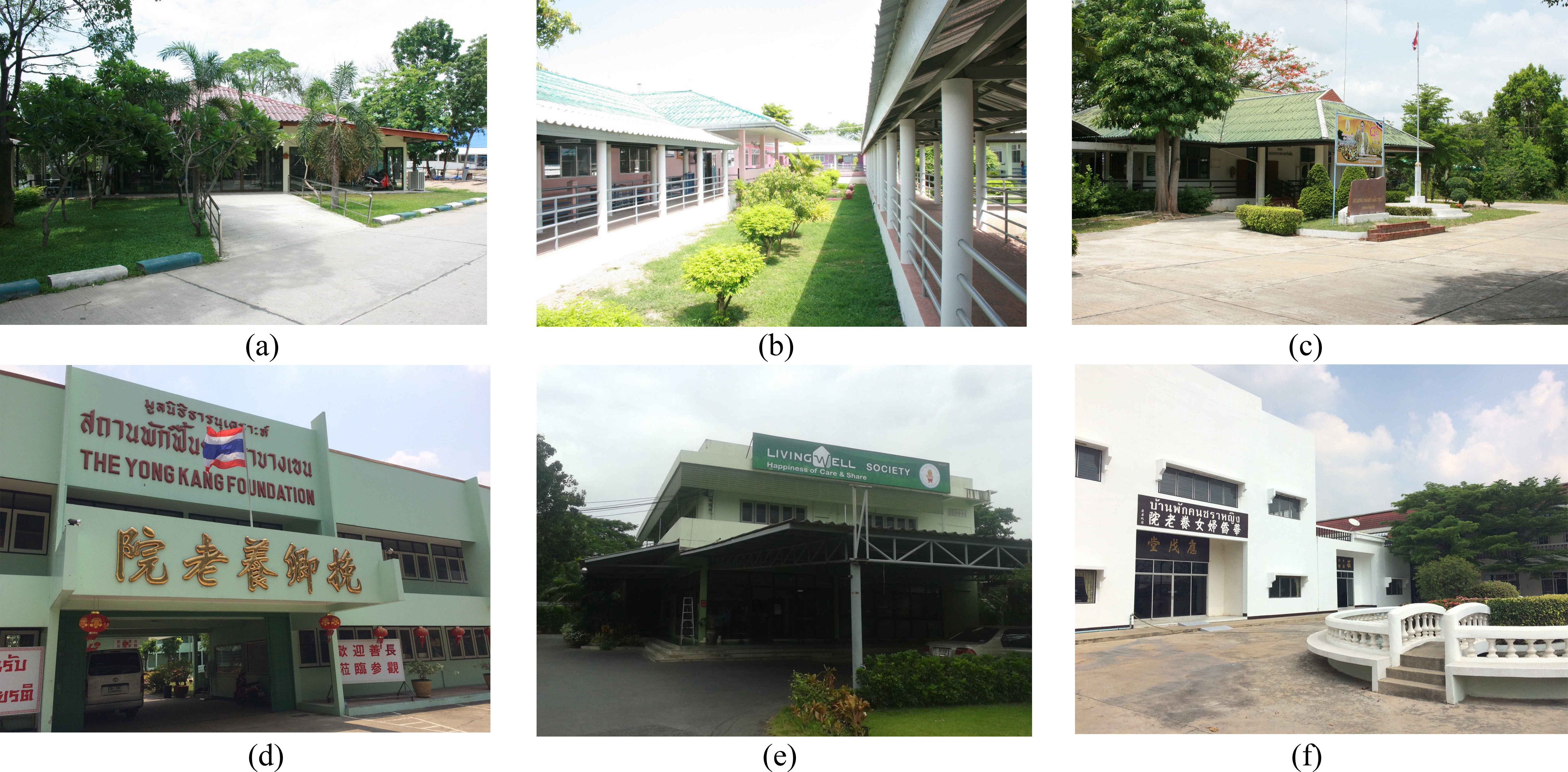 Figure 1
Figure 1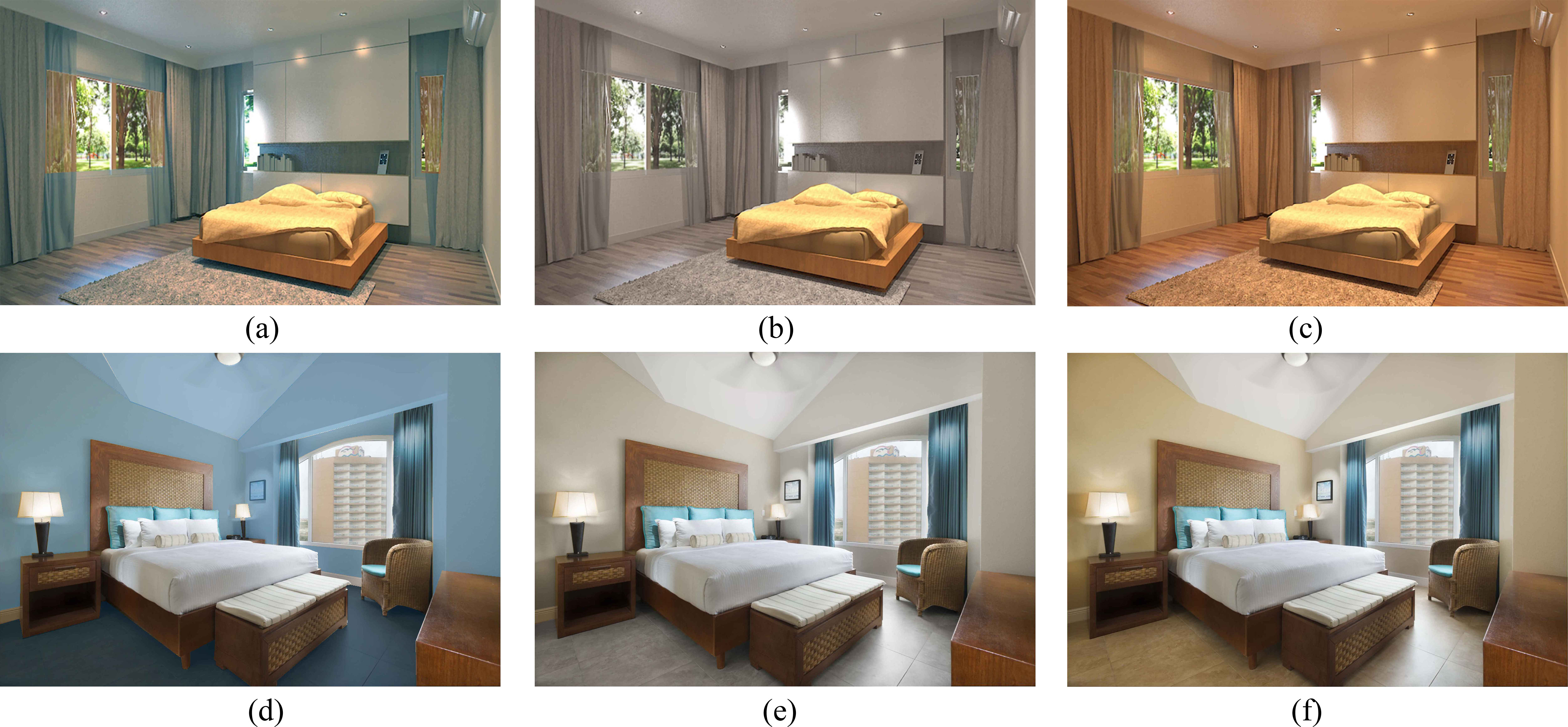 Figure 2
Figure 2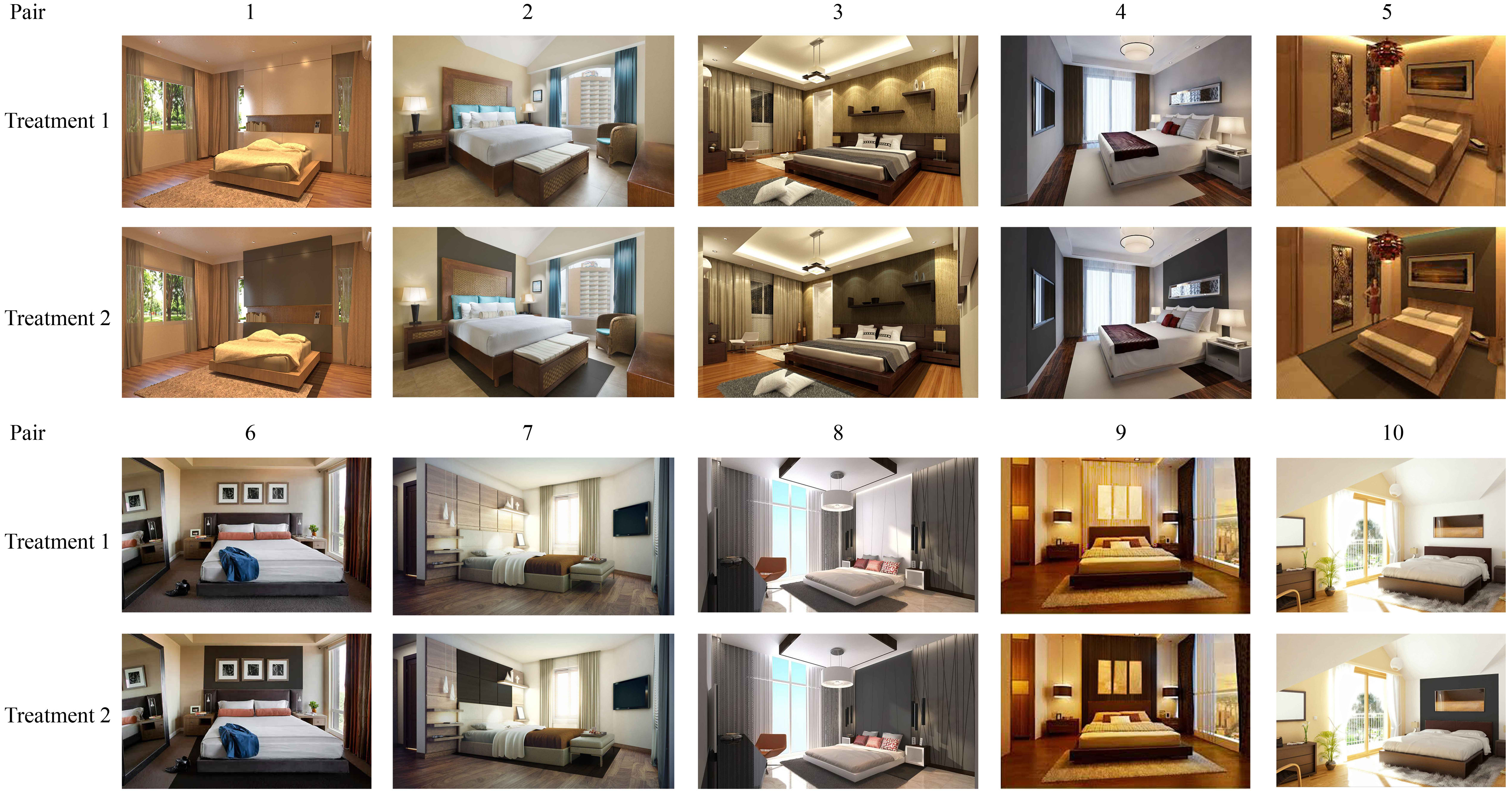 Figure 3
Figure 3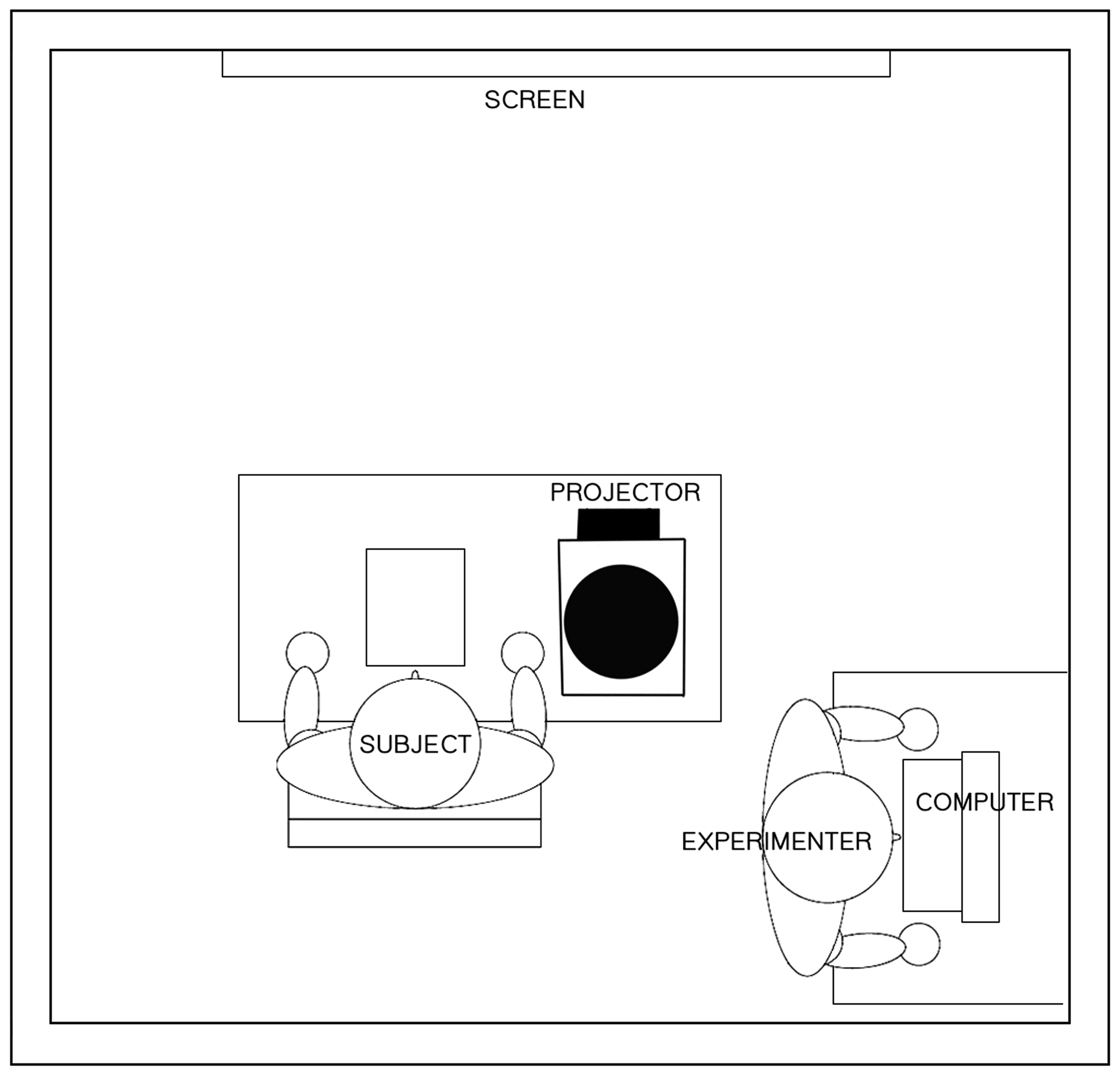 Figure 4
Figure 4 Table 1
Table 1 Table 2
Table 2 Table 3
Table 3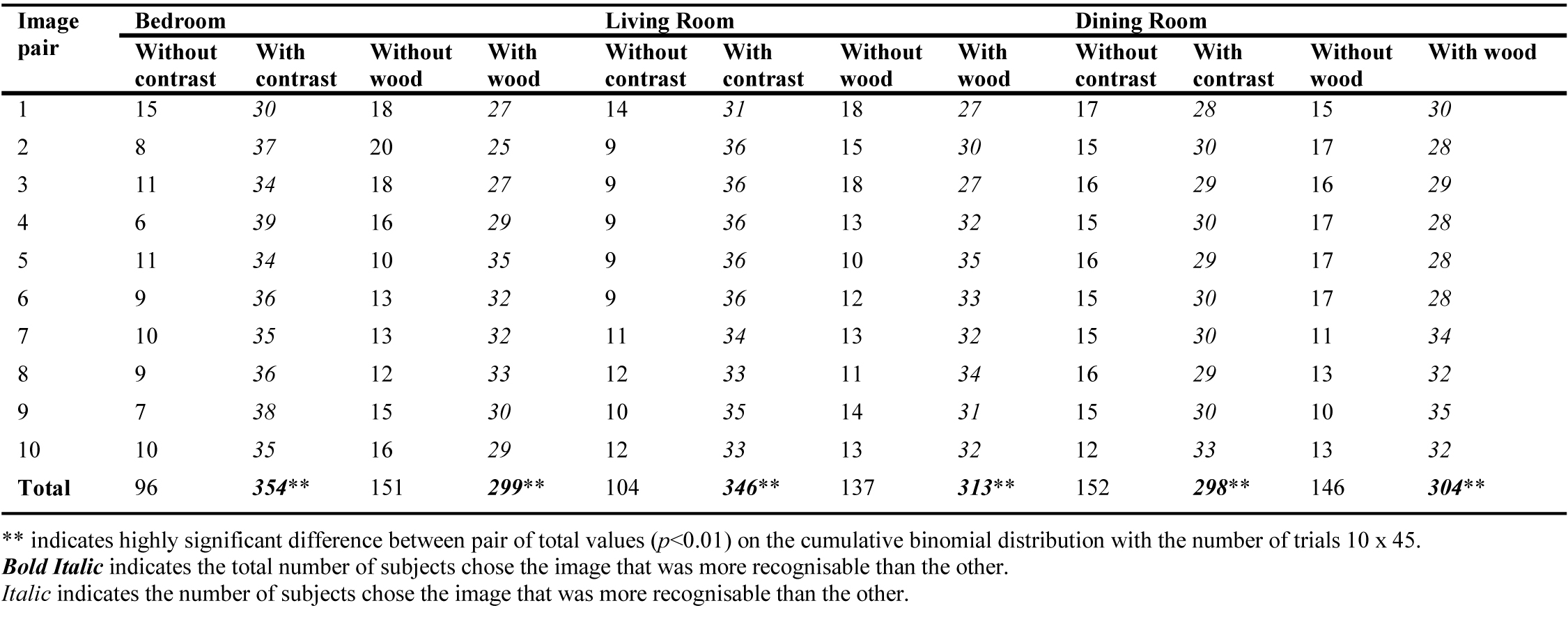 Table 4
Table 4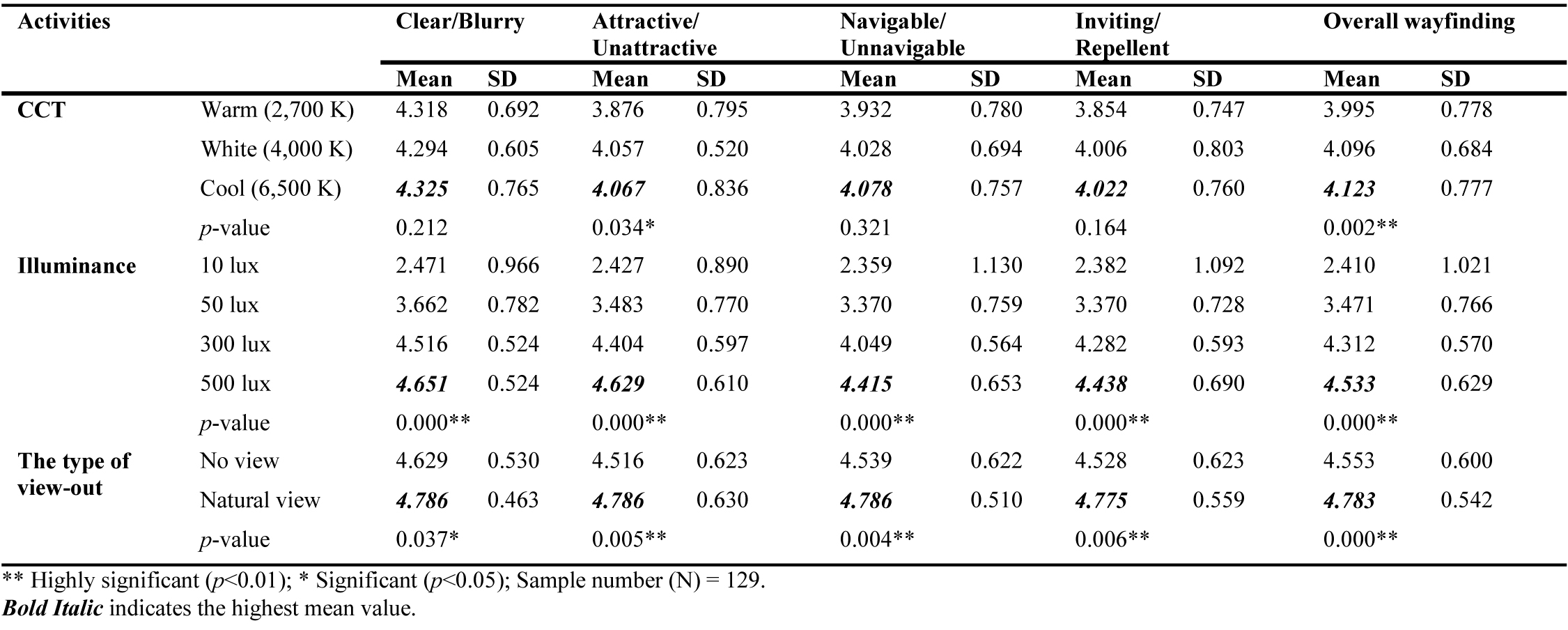 Table 5
Table 5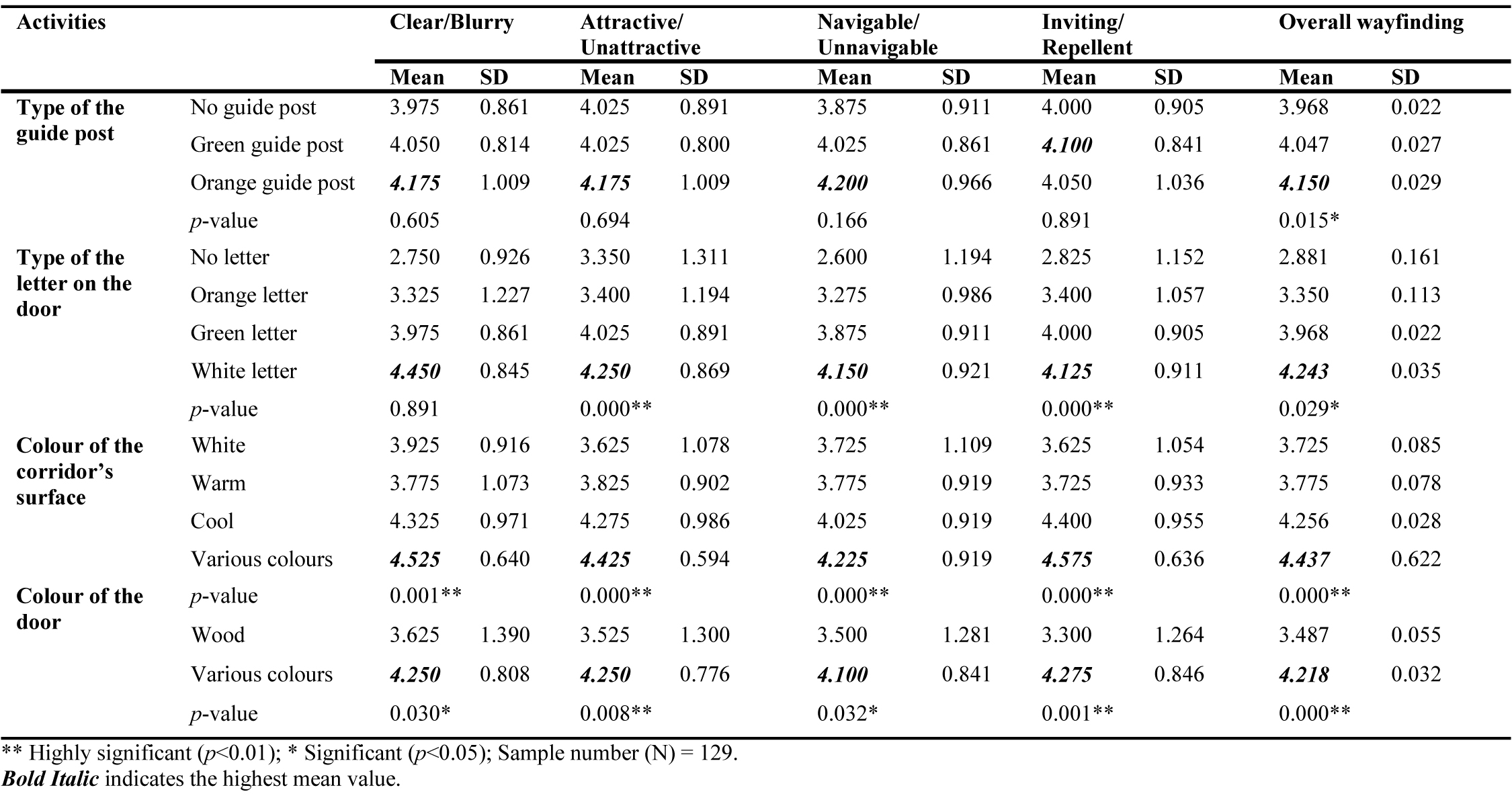 Table 6
Table 6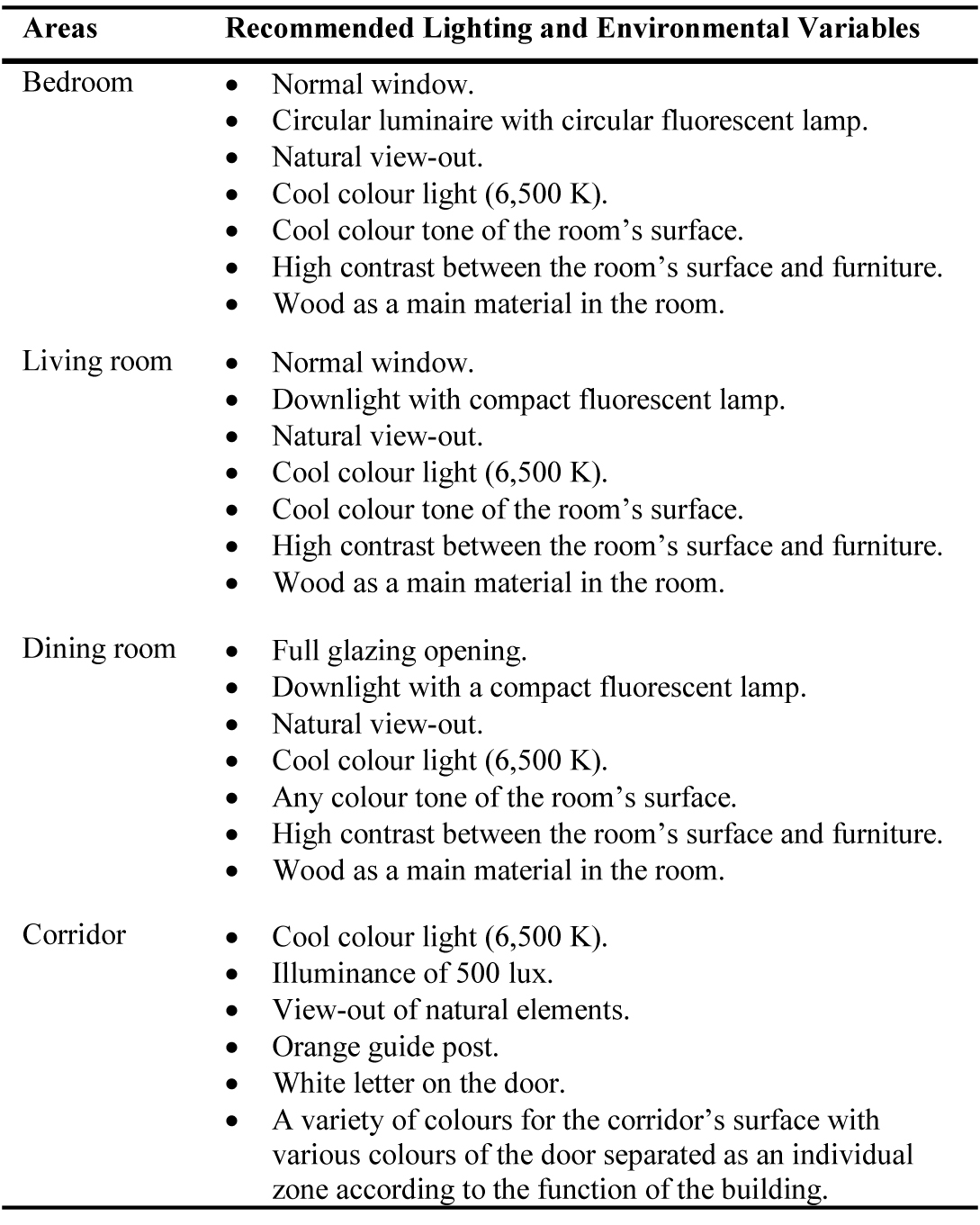 Table 7
Table 7


